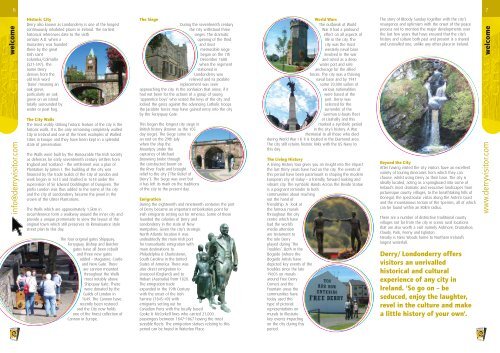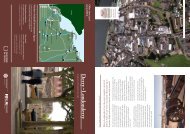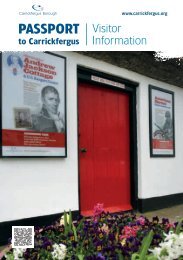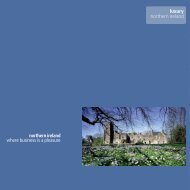Derry Visitor Guide - Discover Northern Ireland
Derry Visitor Guide - Discover Northern Ireland
Derry Visitor Guide - Discover Northern Ireland
You also want an ePaper? Increase the reach of your titles
YUMPU automatically turns print PDFs into web optimized ePapers that Google loves.
7www.derryvisitor.com6info@derryvisitor.com welcomeHistoric City<strong>Derry</strong> also known as Londonderry is one of the longestcontinuously inhabited places in <strong>Ireland</strong>. The earliesthistorical references date to the sixthcentury A.D. when amonastery was foundedthere by the greatIrish saintColumba/Colmcille(521-597). Thename <strong>Derry</strong>derives from theold Irish word‘Daire’ meaning anoak grove,particularly an oakgrove on an islandtotally surrounded bywater or peat bog.The City WallsThe most visibly striking historic feature of the city is thehistoric walls. It is the only remaining completely walledCity in <strong>Ireland</strong> and one of the finest examples of WalledCities in Europe and they have been kept in a splendidstate of preservation.The Walls were built by The Honourable The Irish Societyas defences for early seventeenth century settlers fromEngland and Scotland – the settlement was a plan ofPlantation by James I. The building of the city wasfinanced by the trade Guilds of the City of London andwork began in 1613 and finished in 1618 under thesupervision of Sir Edward Doddington of Dungiven. Theprefix London was thus added to the name of the cityand the city of Londonderry became the jewel in thecrown of the Ulster Plantations.The Walls which are approximately 1.5km incircumference form a walkway around the inner city andprovide a unique promenade to view the layout of theoriginal town which still preserves its Renaissance stylestreet plan to this day.The four original gates Shipquay,Ferryquay, Bishop and Butchergates have all been rebuiltand three new gatesadded – Magazine, Castleand New Gate. Thereare cannon mountedthroughout the Wallsmost notably aboveShipquay Gate. Thesewere donated by theGuilds of London in1649. The Cannon haverecently been restoredand the City now holdsone of the finest collection ofCannon in Europe.The SiegeDuring the seventeenth centurythe City withstood threesieges. The dramaticopening of the thirdand mostmemorable siegebegan on the 7thDecember 1688when the regimentstationed inLondonderry wasrelieved and its Jacobitereplacement was seenapproaching the city. In the confusion that arose, if ithad not been for the actions of a group of young‘apprentice boys’ who seized the keys of the city andlocked the gates against the advancing Catholic troopsthe Jacobite forces may have gained entry into the cityby the Ferryquay Gate.This began the longest city siege inBritish history (known as the 105day siege). The Siege came toan end on the 29th Julywhen the ship theMountjoy under thecaptaincy of MichaelBrowning broke throughthe constructed boom onthe River Foyle and broughtrelief to the city (‘The Relief of<strong>Derry</strong>’). The Siege was over butit has left its mark on the traditionsof the city to the present day.EmigrationDuring the eighteenth and nineteenth centuries the portof <strong>Derry</strong> became an important embarkation point forIrish emigrants setting out for America. Some of thesefounded the colonies of <strong>Derry</strong> andLondonderry in the state of NewHampshire. Given the city’s strategicNorth Atlantic location it wasundoubtedly the main Irish portfor transatlantic emigration withmain destinations toPhiladelphia & Charlestown,South Carolina in the UnitedStates of America. There wasalso direct emigration toLiverpool (England) and toHobart (Australia) from 1820.The emigration tradeexpanded in the 19th Centurywith the onset of the IrishFamine (1845–49) withemigrants setting out forCanadian Ports with the locally basedCooke & McCorkell lines who carried 21,000passengers between 1847–1867 having the mostsizeable fleets. The emigration statues relating to thisperiod can be found in Waterloo Place.World WarsThe outbreak of WorldWar II had a profoundeffect on all aspects oflife in the city. Thecity was the mostwesterly naval baseinvolved in the warand acted as a deepwater port and safeanchorage for the alliedforces. The city was a thrivingnaval base and by 1941some 20,000 sailors ofvarious nationalitieswere based at theport. <strong>Derry</strong> wasselected for thesurrender of theGerman U-boats fleetat Lisahally and thismarked a symbolic periodin the city’s history. A WarMemorial to all those who diedduring World War I & II is located in the Diamond area.The city still retains historic links with the US Navy tothis day.The Living HistoryA Living History tour gives you an insight into the impactthe last thirty years have had on the city. The events ofthis period have been paramount in shaping the modernEuropean city of today – a friendly, forward looking andvibrant city. The symbolic Hands Across the Divide Statueis a poignant reminder to bothcommunities about reachingout the hand offriendship. A look atthe famous muralsthroughout the citycentre which havehad the world’smedia attentionare testament tothe role <strong>Derry</strong>played during ‘TheTroubles’. Both in theBogside (where theBogside Artists havedepicted key events of thetroubles since the late1960’s on muralsaround Free <strong>Derry</strong>Corner) and theFountain areas thecommunities havetoday used thistype of pictorialrepresentations onmurals to illustratekey events impactingon the city during thisperiod.The story of Bloody Sunday together with the city’sresurgence and optimism with the onset of the peaceprocess not to mention the major developments overthe last few years that have ensured that the city’shistory and culture both past and present is a sharedand unrivalled one, unlike any other place in <strong>Ireland</strong>.Beyond the CityAfter having visited the city visitors have an excellentvariety of touring itineraries from which they canchoose, whilst using <strong>Derry</strong> as their base. The city isideally located, acting as a springboard into some of<strong>Ireland</strong>’s most dramatic and evocative landscapes frompicturesque county villages, to the breathtaking hills ofDonegal, the spectacular vistas along the Antrim Coastand the mountainous terrain of the Sperrins, all of whichcan be found within an 80km radius.There are a number of distinctive traditional countyvillages not far from the city in scenic rural locationsthat are also worth a visit namely Ardmore, Drumahoe,Claudy, Park, Feeny and Eglinton.Nearby is Ness Woods home to <strong>Northern</strong> <strong>Ireland</strong>’slargest waterfall.<strong>Derry</strong>/Londonderry offersvisitors an unrivalledhistorical and culturalexperience of any city in<strong>Ireland</strong>. ‘So go on – beseduced, enjoy the laughter,revel in the culture and makea little history of your own’.welcome

















